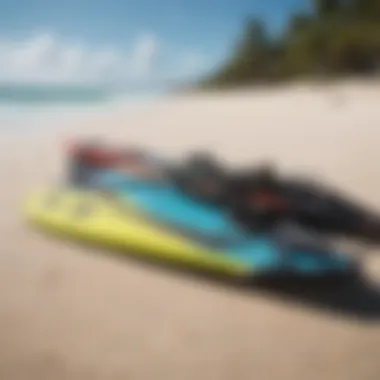Kitesurfing in Tulum: Your Ultimate Guide


Intro
Kitesurfing in Tulum, Mexico, is not just another water sport; it’s an exhilarating experience that combines the thrill of surfing with the grace of flying. The turquoise waters of the Caribbean, harmonizing with steady winds, create a kitesurfing paradise that attracts both beginners and skilled riders. This comprehensive guide walks you through every little detail you need to know about this captivating sport in Tulum.
Whether you're traveling to Tulum for a vacation or to hone your skills, it’s essential to understand both the environment and the equipment that will aid in your kitesurfing journey. Knowing what to pack and what to expect from local conditions can make or break your experience on the water. Tulum's kitesurfing community is not only welcoming but also rich with knowledge, encouraging everyone to immerse themselves in this thrilling adventure.
Let's dive into the second section where we’ll look at the gear and equipment needed for kitesurfing.
Intro to Kitesurfing in Tulum
Kitesurfing in Tulum represents not just a sport, but also a lifestyle. Nestled along the Caribbean coastline of Mexico, Tulum boasts favorable conditions that make it a paradise for those in pursuit of adrenaline and adventure. This vibrant destination is famous for its stunning beaches, clear waters, and, importantly, consistent winds that attract kitesurfers from all corners of the globe.
Tulum's mix of natural beauty and cultural richness creates a unique backdrop for kitesurfing enthusiasts. When the wind picks up and fuels the colorful kites dancing in the sky, it’s evident why both seasoned riders and newcomers flock to this locale. The local atmosphere is saturated with warmth from both the sun and the community, making the experience here feel like coming home.
Importance of Tulum as a Kitesurfing Destination
Tulum's reputation as a premier kitesurfing location stems from several key factors. First and foremost are its wind conditions. Generally blowing consistently from November through May, the wind provides an ideal playground for kitesurfers. The conditions here cater to a variety of skill levels, from beginners just finding their footing to advanced practitioners seeking thrilling waves.
In addition to the wind, another crucial element is the expansive shallow waters just off the coast. These waters offer a safe landing zone for practicing tricks and learning new moves. The sandy bottom is gentle on falls, reducing the fear that often accompanies water sports.
Moreover, Tulum itself is a hub for wellness and outdoor activity. Many local businesses offer kitesurfing lessons, gear rentals, and guided tours. This means that you don’t need to be an expert to enjoy the sport; trained instructors stand ready to help anyone dive into kitesurfing with enthusiasm. In essence, Tulum delivers a complete experience that pairs adventure with relaxation, making it a top spot for this exhilarating pastime.
Overview of Kiteboarding as a Sport
Kiteboarding, often called kitesurfing, is a sport that fuses elements of windsurfing, surfing, and paragliding. At its core, the sport involves riding a board while being pulled across the water by a large, controllable kite. The thrill comes from gliding over waves, performing acrobatics, and enjoying nature in a very direct way. Kiteboarding offers an unparalleled sense of freedom as you harness the wind's power.
For those curious about getting started, it’s worth noting that kiteboarding is accessible to everyone. Unlike other extreme sports, age and fitness levels do not pose significant restrictions. With some practice and proper guidance, many learn to ride in just a few lessons.
Kiteboarding isn’t merely about skill; it’s also about community. Visiting a place like Tulum exemplifies how deeply this sport is intertwined with the culture. Kitesurfers often connect during sessions on the water, sharing tips, discussing equipment, or even just enjoying a post-surf drink. This camaraderie transforms the solitary activity into a communal experience, fostering lasting friendships and connections among enthusiasts.
Overall, kitesurfing in Tulum propels both sport and lifestyle to new heights, offering a unique blend of challenge and enjoyment, all in a breathtaking environment.
Kitesurfing Conditions in Tulum
Kitesurfing is a thrilling endeavor, but the conditions in which one practices this sport can make a world of difference. Tulum, with its stunning coastline and predictable weather patterns, serves as a prime location for both beginners and seasoned boarders. Knowing the specific kitesurfing conditions is essential for safely enjoying the sport while maximizing the fun.
The kitesurfing conditions in Tulum encompass a few critical factors: wind patterns, water conditions, and the best times of the year to get on the water. Understanding each element helps not just in gear selection but also in planning your kitesurfing outings effectively.
Wind Patterns and Their Significance
When it comes to kitesurfing, wind is king. In Tulum, the wind patterns generally originate from the east and are most consistent from late November to early May. During this period, kiteboarders can expect strong, steady winds averaging 15 to 25 knots. This consistency makes it an ideal time for enthusiasts looking to improve their skills or simply enjoy the sport to the fullest.
A common phrase among kitesurfers is, "Good wind equals good times." Here, the meaning is clear: favorable wind conditions can make or break your session. However, it’s not just about wind strength. The direction of the wind matters too. Side-on winds help reduce the risk of being blown too far offshore, allowing a safe experience while allowing plenty of room to ride and maneuver.
Water Conditions and Safety


Water conditions in Tulum can vary, presenting an exhilarating experience for riders. The turquoise waters are generally flat to choppy, mainly influenced by the wind. These variations affect not only the ride quality but also the skill level required. It's essential to be mindful of tidal changes, as tides can create additional challenges such as stronger currents.
In terms of safety, being aware of the local environment is crucial. Tulum’s waters are home to vibrant marine life, so it's wise to keep an eye out for coral reefs and seaweed patches which could be hazardous.
Safety tips include:
- Always check local conditions before heading out.
- Wear appropriate safety gear, including impact vests.
- Familiarize yourself with the area.
Prioritizing safety enhances the overall experience and ensures that kitesurfing remains an exhilarating yet secure activity.
Best Time of Year for Kitesurfing
In Tulum, the best months for kitesurfing align perfectly with the winter and spring seasons. From late November until early May, the reliable wind conditions coupled with warm water temperatures offer an inviting atmosphere for kitesurfers.
To narrow it down:
- November to December: Winds start to pick up, making it the beginning of the kiting season.
- January to March: This period provides the most consistent trade winds and ideal conditions. The bustling kitesurfing community is in full swing, drawing many enthusiasts.
- April to May: Winds gradually begin to die down but remain enjoyable.
With this knowledge about the kitesurfing conditions in Tulum, anyone trying their hand at the sport can better understand the elements that will enrich their experience while ensuring their safety on the water.
"Not all who wander are lost, but those who kite in Tulum certainly know where they're going!"
As you prepare for a kitesurfing adventure in Tulum, keep these conditions at the forefront of your plan, and you are bound to have an unforgettable time on the water.
Essential Gear for Kitesurfing
Kitesurfing is more than just a sport. It’s an experience that combines the thrill of adventure with the beauty of nature. To truly enjoy the winds and waves in Tulum, having the right equipment is crucial. You can't just hop on a board without the essential gear; it's like going for a swim with a brick in your pocket. Let’s dive into what you need to make your kitesurfing sessions truly enjoyable and safe.
Kites: Types and Sizes
When it comes to kites, one size does not fit all. It's about matching your kite to your skills, the wind conditions, and even the type of riding you want to do. There are generally three types of kites:
- C-kites: Known for their performance in freestyle and big air. They offer great power and solid pull.
- Bow kites: They are ideal for beginners. With their larger wind range and easier relaunch capabilities, they provide stability and control.
- Delta kites: These combine the features of C and bow kites, perfect for all riding styles.
Size matters too. For instance, in lighter winds, you might wanna opt for something larger, like a 12-meter kite, while in stronger winds, a 7-meter kite would work better. Always remember: picking the appropriate kite size is as important as choosing the right vehicle for a road trip.
Boards: Choosing the Right Type
Selecting the right board is akin to choosing the right shoes for a hike. You wouldn't wear flip-flops on a long trek, would you? Much like that, your board should fit your style and experience. There are two main categories:
- Twin-tip boards: Great for beginners and those looking to ride in both directions. They offer a balanced ride and are very forgiving.
- Directionals: These are for the more advanced riders who prefer surfing waves or going downwind. They handle differently and require more skill to master.
Not to forget, consider your weight and the type of water you’ll be riding in. A heavier rider might need a bigger board to float better in the water, whereas lighter riders can often get away with a smaller board.
Safety Equipment: Harnesses and Impact Vests


Safety can be the thin line between an exhilarating session and a potential mishap. Harnesses come in various forms, with the two main types being:
- Waist harnesses: These sit on your waist and allow for more freedom of movement. They are often favored by those who like freestyle.
- Seat harnesses: These provide more support and are ideal for beginners or those who prefer comfort over style.
But harnesses are just part of the equation. Impact vests are another important piece. They protect your torso when falling hard on the water. It adds an additional layer of safety, which is always a good idea when you’re practicing those high jumps or tricky maneuvers.
"Diving into kitesurfing without the right safety gear is like trying to cook without a stove. You can manage, but it won’t go well."
The Role of Wetsuits in Kitesurfing
While Tulum may have warm waters, the wind can still give you the chills, especially during the early morning or late afternoon sessions. Wetsuits serve a dual purpose: they keep you comfortable and protect against scrapes and sunburn. There are various thicknesses available, generally ranging from 2mm to 5mm.
- Shorty wetsuits: Perfect for warm weather; these cover your torso but leave your arms and legs free.
- Full wetsuits: Best for those chillier days or if you’re going for extended sessions in cooler water. They’ll keep you warm and let you stay out longer.
Choosing the right wetsuit is not just about warmth—it's also about flexibility. You want something that allows you to move easily while you’re catching that sweet wave or making sharp turns.
Kitesurfing Schools and Lessons in Tulum
When it comes to kitesurfing, having the right foundation can make all the difference. Lessons provide not just technical know-how but also the confidence needed to navigate the wind and waves. In Tulum, an increasingly popular hotspot, the presence of various kitesurfing schools makes it accessible to all levels. Knowing where to go for lessons can determine your progression as a kiteboarder, regardless if you're a novice or someone looking to refine your skills.
Reputable Schools: A Guide
Finding a reliable kitesurfing school is crucial. In Tulum, several schools have earned a good reputation over the years. Schools such as Tulum Kitesurfing and Kite Tulum stand out for their experienced instructors and safety measures. They offer different courses tailored to various experience levels.
One significant factor to consider is the instructor-to-student ratio. Smaller groups often result in tailored instructions and can accelerate learning.
- Tulum Kitesurfing: Known for its small class sizes and patient instructors, it's a good choice for beginners. The school's commitment to safety is evident in its practices and equipment.
- Kite Tulum: More suited for intermediate and advanced kiteboarders, they provide coaching to refine techniques and handle more challenging conditions.
Both schools emphasize environmental consciousness, ensuring that their lessons align with responsible kitesurfing practices. Research your options, and maybe even drop by to chat with instructors—first-hand impressions can guide your decision.
What to Expect in a Lesson
So, what's a typical kitesurfing lesson look like in Tulum? Expect a blend of theory and practice. Most lessons begin with a safety briefing; you will learn about equipment, wind direction, and ocean conditions. Here's a breakdown of what you might experience:
- Introduction to Gear: Understanding the parts of the kite and board is essential. Instructors will show you how to set up your equipment before hitting the water.
- Safety Protocols: Knowing safety measures is as vital as learning to kite. You'll be trained on how to handle emergencies and communicate with other surfers.
- Water Time: Once everything is in place, you will spend a large portion of the lesson practicing on the water. Starting with body dragging to control the kite without a board, you’ll gradually work up to riding.
- Feedback: Instructors will provide feedback throughout the lesson. Their guidance helps learners correct mistakes and improve their techniques, ensuring that practice leads to progression.
Learning kitesurfing in Tulum offers not just the thrill but also a path paved with safety and skill. Each experience with the water in this paradise can contribute significantly to a kitesurfer's journey.
The Kitesurfing Community in Tulum
The kitesurfing community in Tulum is not just a group of individuals sharing the same sport; it’s a vibrant, interconnected network that enhances the experience of kitesurfing in this beautiful setting. The appeal of Tulum goes beyond its stunning beaches and ideal wind conditions. Here, kitesurfers find camaraderie, support, and a sense of belonging that adds depth to their practice.
Local Events and Competitions
One of the highlights of being part of the kitesurfing community in Tulum is the variety of local events and competitions that take place throughout the year. These events aren't merely contests; they're gatherings that promote culture, skill sharing, and a friendly spirit of competition. Often, they attract both local talent and international participants, fostering a competitive yet inclusive environment.


The Tulum Kite Festival is an example worth mentioning. It's a time when both novice and experienced kitesurfers come together, showcasing their skills while also enjoying workshops, vendor booths, and demonstrations. This festival not only hones your skills but also allows artists and local businesses to shine, creating a lively atmosphere. Here’s a quick rundown of what participants can expect:
- Workshops on advanced techniques and safety tips
- Competitions ranging from friendly races to skill-based challenges
- Social events including beach parties and after-parties to connect with other kiteboarders
These local events are crucial for anyone looking to immerse themselves in the Tulum kitesurfing scene. The sheer energy of the crowd, mixed with the thrill of competition, makes it a unique experience.
Networking with Other Enthusiasts
The kitesurfing community in Tulum is particularly welcoming, making it the perfect environment for networking with other enthusiasts. Whether you are a seasoned pro or just starting, finding like-minded people enhances your enjoyment. Local beach spots like Playa Las Palmas and the area around the Tulum ruins serve as informal meeting grounds for surfers to share tips, experiences, and even gear.
One strategy many use to connect is through social media platforms like Facebook and Reddit, where specific groups focus on Tulum kitesurfing. Here, you can find groups dedicated to sharing experiences, checking up on weather conditions, arranging meet-ups, and exchanging advice about the best local spots.
A few benefits of networking include:
- Skill Sharing: More experienced riders often mentor newcomers, helping them avoid common pitfalls and accelerate their learning curve.
- Gear Exchange: It’s common for locals to trade or rent equipment, making it easier for travelers or those just starting out.
- Friendships: Many lasting friendships are born from shared adventures on the water, enriching the kitesurfing experience.
In summary, the kitesurfing community in Tulum is a cornerstone of the sport's culture there. The blend of local events, friendly networking opportunities, and a supportive atmosphere makes it the perfect place for both casual kiteboarders and serious athletes.
Environmental Considerations
Kitesurfing, while exhilarating and filled with the promise of adventure, comes with its own set of environmental implications. In Tulum, where crystal-clear waters meet sandy shores, the juxtaposition of recreation and conservation becomes increasingly relevant. Understanding the impact of kitesurfing on the local ecosystem is essential for maintaining the natural splendor of this choice destination. The balance between enjoying the thrill of kitesurfing and preserving Tulum’s rich biodiversity is a topic that cannot be overlooked.
Conservation Efforts in Tulum
In Tulum, conservation efforts have gained significant traction, particularly as awareness of environmental issues grows. Local authorities and organizations have initiated programs aimed at protecting marine life and coastal ecosystems. For example, the Tulum National Park, which stretches along a stunning shoreline, limits certain activities during breeding seasons for various species.
Moreover, several non-profit organizations are actively involved in marine conservation, focusing on protecting coral reefs, which are crucial to the marine habitats in Tulum. These reefs not only act as natural barriers against storm surges but also promote a thriving biodiversity.
Collaboration between local businesses and conservation groups has resulted in initiatives like beach clean-ups and awareness campaigns. Such efforts are vital; they serve as a reminder about the effects of litter and pollution, encouraging kitesurfers to leave the beaches better than they found them. As kitesurfers, it’s important to engage with these conservation efforts, as they directly contribute to the longevity of the sport by ensuring the environment remains healthy and vibrant.
Sustainable Kitesurfing Practices
Practicing kitesurfing sustainably is not just beneficial for the environment; it also enriches the overall experience for everyone involved. Here are several practices kiteboarders can adopt to minimize their impact:
- Choose Eco-Friendly Gear: Select equipment made from sustainable materials when possible. Some brands are beginning to focus on environmentally friendly manufacturing processes.
- Follow Local Guidelines: Always adhere to the regulations set by local authorities and conservation groups. This might include respecting no-surf zones and speed limits in certain areas.
- Educate Yourself and Others: Knowledge is power. By understanding the ecosystems around, kiteboarders can make informed choices that promote sustainability.
- Participate in or Organize Clean-up Drives: Getting involved with local conservation programs, like coastal clean-up initiatives, can be a rewarding way to contribute positively.
"Every kite surfer has the potential to protect the environment they enjoy. It’s a matter of choice."
By adopting these sustainable practices, kitesurfers can enjoy the mesmerizing waves of Tulum while ensuring that the environment remains intact for future generations. The goal is straightforward: enjoy the sport you love but do so with the awareness that the health of the local ecosystem ultimately affects your experience. In this way, the Tulum kitesurfing community can remain both vibrant and ecologically sound.
Closure
As we draw our exploration of kitesurfing in Tulum to a close, it’s essential to reflect on how this guide encapsulates the unique appeal of this incredible sport in such a captivating locale. Kitesurfing is not just a pastime here; it embodies a lifestyle that intertwines the thrill of adventure with the serene beauty of Tulum’s beaches. Whether you’re a fledgling kiteboarder or a seasoned veteran, understanding the nuances of this sport in Tulum is crucial.
The Future of Kitesurfing in Tulum
Regarding the future of kitesurfing in Tulum, several factors must be considered. Tulum's popularity as a destination is ever-growing, and with that, the influx of both beginners and experienced kitesurfers is bound to rise. This trend brings with it bountiful opportunities for expansion:
- Infrastructure Development: As demand increases, we can anticipate more kitesurfing schools, equipment rental shops, and enhanced launch sites. These enhancements will cater to both novices needing instruction and experts looking for advanced gear.
- Sustainability Initiatives: The growing awareness of environmental issues means that kitesurfing in Tulum will likely evolve to prioritize eco-friendly practices. Efforts to preserve the natural beauty of beaches and the surrounding ecosystems are vital. Local clubs and organizations may push forward education on responsible kitesurfing, ensuring the area remains pristine for future generations.
- Community Engagement: The local kitesurfing community is incredibly vibrant, and its passion is likely to result in the organization of more competitions and events. These happenings not only foster camaraderie among kitesurfers but also put Tulum on the map as a significant player in the global kitesurfing scene.
In summation, kitesurfing in Tulum is set to flourish, driven by a combination of community spirit, environmental consciousness, and infrastructural support. As the waves beckon, both the local and visitor kitesurfers must navigate the waters of change prudently. Embracing sustainable practices while enjoying the thrill of kitesurfing will ensure this sport continues to thrive in one of the most beautiful coastal enclaves in the world.















